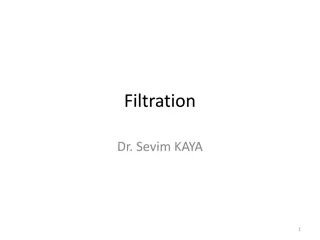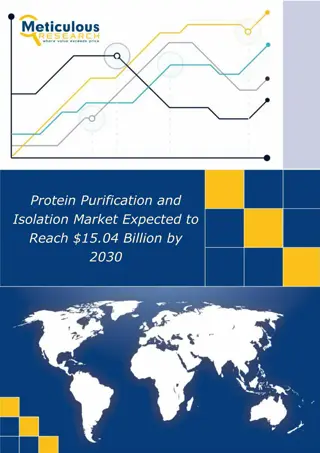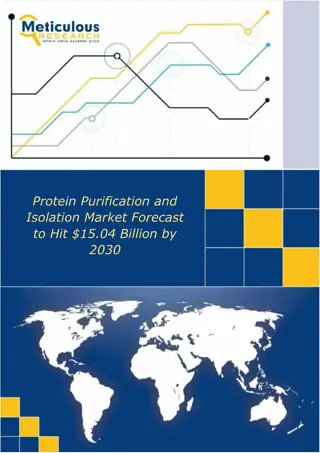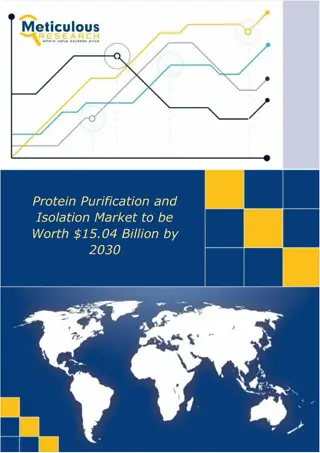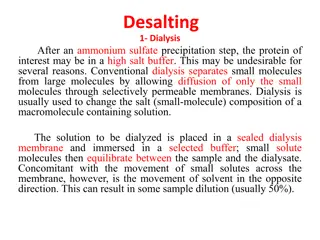Ultrafiltration Rate in Hemodialysis
Ultrafiltration rate (UFR) plays a crucial role in in-center hemodialysis by determining the rate at which fluid is removed during a session. It is not part of the basic prescription but is calculated and adjusted throughout treatment. Recent focus on UFR is due to its association with outcomes and the CMS plan to include it in quality incentive programs. Factors like interdialytic weight gain and treatment time are key determinants of UFR, with higher UFR associated with increased mortality and cardiovascular risks. Despite previous lack of attention, understanding and monitoring UFR is essential for optimizing hemodialysis outcomes.
Download Presentation

Please find below an Image/Link to download the presentation.
The content on the website is provided AS IS for your information and personal use only. It may not be sold, licensed, or shared on other websites without obtaining consent from the author. Download presentation by click this link. If you encounter any issues during the download, it is possible that the publisher has removed the file from their server.
E N D
Presentation Transcript
Volume Management in In-Center Hemodialysis Jay Hawkins, MD
Disclosures Member of the Medical Advisory Board for Fresenius Kidney Care
Ultrafiltration Rate Why are we talking about this? -it is not part of the basic HD prescription -calculated at the start of HD and prescribed by the tech/nurse -modified frequently throughout the HD treatment Recently brought to the forefront of conversation due to CMS plan to add ultrafiltration rate to the ESRD quality incentive program. Is it important?
Case presentation Mr. Thirsty is a 43 y.o. male with ESRD related to PKD. He has been on in- center hemodialysis for 8 months. He runs 3.5 hours on a TTS schedule. He tolerates hemodialysis fairly well though frequently complains of cramps if he gets to dry . He presents to dialysis today 4 kg above his dry weight. Exam shows BP of 148/84, pulse 88, weight 80 kg. Lungs are clear, Heart RRR, no appreciable edema. He has a left forearm AVF which has been working well.
Ultrafiltration Rate A composite metric dependent on 2 factors: -Interdialytic weight gain (IDWG) < 2.5% or > 3.5% of body weight has worse outcomes -Treatment time (TT) Dialysis session length < 240 min has worse outcomes Both factors have been independently associated with greater mortality.
Ultrafiltration Rate Independent predictor of mortality Associated with increased cardiovascular mortality Associated with cardiac dysfunction Associated with increased hypotension Associated with dialysis tolerance/satisfaction
Ultrafiltration Rate So why does it seem like UFR was not getting attention? -Observational studies (can only infer an association) -Difficulty in differentiating treatment time (TT) from UFR Decreasing UFR necessarily increases TT Prolonged TT improves outcomes irrespective of Kt/V -Residual renal function leads to lower UFR -Absence of an objective volume status assessment tool
IDWG Outcomes of high IDWG -High UFR -intradialytic hypotension -Failure to attain dry weight Outcomes of low IDWG -Decreased BMI -Impaired nutritional markers Goal IDWG may be 2.5-3.5% of dry weight
Mr. Thirsty Lets do some math in regards to Mr. Thirsty: 76 kg dry weight > 2.6 liter weight gain increased mortality < 1.9 liter weight gain increased risk of impaired nutrition 4 liter weight gain > 140 kg patient (308 lbs)
IDWG Causes of increased thirst/fluid intake -Reduced cardiac output (decreased effective circulating volume) -High oral sodium intake -Sodium load from dialysis (sodium profile or saline infusion) -hyperglycemia -Psychiatric -younger age (increased appetite, increased sodium intake)
High IDWG Rapid ultrafiltration rates Greater fluid shifts Myocardial stunning and ischemia Intradialytic hypotension Hemodynamic destabilization Interruptions in end-organ perfusion
High IDWG Failure to attain dry weight Chronic volume overload Left ventricular hypertrophy Cardiac fibrosis Distortion of cardiac conduction pathways Increased risk for arrhythmias Increased risk for sudden cardiac death
So what is the goal? 1. Encourage appropriate IDWG 2. Prescription modification to maintain a safe UFR For 2019 ESRD QIP: US Centers for Medicare and Medicaid Services (CMS) -Recommend an UFR < 13 ml/kg/h. -Currently CMS is collecting information on UF rates.
Whats the evidence? UFR > 10 mL/kg/hr was associated with a higher risk of mortality and increased odds of IDH. UFR > 12.3 mL/kg/hr was independently associated with increased long-term risk of death.
Whats the evidence? Compared with UFR 10 mL/kg/hr, UFR > 13 mL/kg/hr was significantly associated with increased all-cause mortality and specifically increased CV mortality. UFR 10-13 mL/kg/hr was associated with increased all-cause mortality but only had an intermediate association with CV mortality and not statistically significant.
How do we get there? Cap UFR at 13 mL/kg/hr? Increase treatment time? Decrease interdialytic weight gain?
Management Cap the ultrafiltration rate There is an association between above target weight misses and increased cardiovascular and all-cause mortality. Thrice-weekly HD patients with 1 weekly treatment post-weight > 2 kg above target weight are at increased risk for adverse outcomes. Failure to attain dry weight Chronic volume overload Left ventricular hypertrophy Cardiac fibrosis Distortion of cardiac conduction pathways Increased risk for arrhythmias Increased risk for sudden cardiac death
Management Extend the treatment time Strict shift schedule Limited space -Would need ~ 17-33 hours/wk/unit Limited personnel resources Financial constraints Patient preference -Only 20% willing to increase TT
Management Decrease IDWG Fluid restriction -40% of patients admit to near daily nonadherence Salt restriction Additional weekly HD session -Acceptable to only 12% of patients Diuretics -Only feasible in those with residual renal function Behavioral changes in dialysis are complex and onerous. We need a multi-disciplinary approach to assist our patients who have excessive IDWG!!
Care Tech Most time spent in direct care with the patient Notify patients of their dry weight -30% of patients do not know their dry weight Notify patients of the IDWG -26% of patients to not know the amount of their fluid gains Reinforce adherence to therapies. Probe for roadblocks to adherence
Nurse Education Risks of excessive IDWG Risks of excessive UFR Risks of chronic fluid overload Problem solve Monitor for change in patient status Changes in volume status
Dietician Education on low-salt diet Education and strategies for fluid restriction Identification of dietary misadventures
Social Worker Screen for depression -depression and lack of motivation is a barrier to adherence to fluid restriction Assist in finding unique options for managing roadblocks to adherence
Nephrologist Generally the least involvement Education Establish an appropriate dry weight Prescribe appropriate dialysis Reinforce interventions from other disciplines Identify intervening complications
Mr. Thirsty 1. Does Mr. Thirsty have an increased risk for volume associated complications? I think so 2. What do I need to know His actual dry weight What was his: Weight at the end of his last HD Weight at the end of his last several dialysis sessions Actual fluid gains since his last dialysis session Post HD blood pressure readings Volume status by physical exam
Mr. Thirsty Post HD weight Post HD BP 7/31/18 77.3 kg 123/77 8/2/18 76.9 kg 105/68 8/4/18 77.6 kg 126/80 Actual dry weight appears to be around 77.5 kg.
Mr. Thirsty Let us revisit the math: 77.5 kg dry weight 2.5 liter fluid gain Max UFR of 988 ml/h 2 hr 32 min to reach dry weight assuming 2.5 liter IDWG With an appropriate evaluation, including attention to post-dialysis weights and blood pressure, Mr. Thirsty is at goal for both fluid gains and UFR.
Bibliography Assimon MM, Flythe JE. Rapid ultrafiltration rates and outcomes among hemodialysis patients: re-examining the evidence base. Curr Opin Nephrol Hypertens 2015; 24: 525- 530. Brunelli SM, Chertow GM, Ankers ED et al. Shorter dialysis times are associated with higher mortality among incident hemodialysis patients. Kidney Int 2010; 77: 630-636. Burton JO, Jefferies HJ, Selby NM et al. Hemodialysis-induced cardiac injury: determinants and associated outcomes. Clin J Am Soc Nephol 2009; 4: 914-920. Flythe JE, Assimon MM, Wenger JB et al. Ultrafiltration rates and the Quality Incentive Program: proposed measure definitions and their potential dialysis facility implications. Clin J Am Soc Nephrol 2016; 11: 1422-1433. Flythe JE, Curhan GC, Brunelli SM. Disentangling the ultrafiltration rate-mortality association: the respective roles of session length and weight gain. Clin J Am Soc Nephrol 2013; 8: 1151-1161. Flythe JE, Kimmel SE Brunelli SM. Rapid fluid removal during dialysis is associated with cardiovascular morbidity and mortality. Kidney Int 2011; 79: 250-257. Flythe JE, Curhan GC, Brunelli SM. Shorter length dialysis sessions are associated with increased mortality, independent of body weight. Kidney Int 2012; 83: 104-113. Flythe JE, Mangione TW, Brunelli SM et al. Patient-stated preferences regarding volume- related risk mitigation strategies for hemodialysis. Clin J Am Soc Nephrol 2014; 9: 1418- 1425. Holmberg B, Stegmayr BG. Cardiovascular conditions in hemodialysis patients may be worsened by extensive interdialytic weight gain. Hemodial Int 2009; 13: 27-31.
Bibliography Jefferies HJ, Virk B, Schiller B et al. Frequent hemodialysis schedules are associated with reduced levels of dialysis-induced cardiac injury (myocardial stunning). Clin J Am Soc Nephrol 2011; 6: 1326-1332. Lopez-Gomez JM, Villaverde M, Jofre R et al. Interdialytic weight gain as a marker of blood pressure, nutrition, and survival in hemodialysis patients. Kidney Int 2005; 67(Supple93): s63-s68. Movilli E, Gaggia P, Zubani R et al. Association between high ultrafiltration rates and mortality in uraemic patients on regular haemodialysis. A 5-year prospective observational multicentre study. Nephrol Dial Transplant 2007; 22: 3547-3552. National Kidney Foundation. KDOQI clinical practice guideline for hemodialysis adequacy: 2015 update. Am J Kidney Dis 2015: 66: 884-930. Saran R, Bragg-Gresham JL, Levin NW et al. Longer treatment time and slower ultrafiltration in hemodialysis: associations with reduced mortality in the DOPPS. Kidney Int 2006; 69: 1222-1228. Sharp J, Wild MR, Gumley AI et al. A cognitive behavioral group approach to enhance adherence to hemodialysis fluid restrictions: a randomized controlled trial. Am J Kidney Dis 2005; 45: 1046-1057. Sharp J, Wild MR, Gumley AI. A systematic review of psychological interventions for the treatment of nonadherence to fluid-intake restrictions in people receiving hemodialysis. Am J Kidney Dis 2005; 45: 15-27. Tentori F, Zhang J, Li Y et al. Longer dialysis length is associated with better intermediate outcomes and survival among patients on in-center three times per week hemodialysis: results from the dialysis outcomes and practice patterns study (DOPPS). Nephrol Dial Transplant 2012; 27: 4180-4188.







